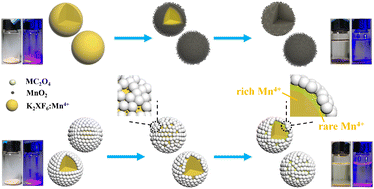Insoluble oxalates modified K2XF6:Mn4+ (X = Ti, Ge, Si) red-emitting phosphors exhibiting excellent moisture resistance and luminescence for warm white light-emitting diodes†
Abstract
K2XF6:Mn4+ (X = Ti, Ge, Si) phosphors are attractive red-light sources in the warm white light-emitting diodes. However, these fluorides suffer from hydrolysis in moist environments, making them less acceptable in the lighting market. Insoluble MC2O4 (M = Ca, Sr, Ba, Mn) was modified on the fluorides’ surfaces to prevent the hydrolysis of internal [MnF6]2− groups and promote the reduction of exposed Mn4+ ions into Mn2+ ones. The reaction mechanism was studied, as well as the effect of modification on the crystal structures and particle morphologies. The luminescence properties of CaC2O4 modified fluorides were studied in detail. The luminescence weakens with increasing coatings because of light scattering at the interfaces. However, the luminescence intensity exceeded its initial value after being immersed in water even for 200 h. Besides, the modified fluorides possessed excellent thermal stability than the original ones. The LED devices made using commercial Y3Al5O12:Ce3+ and CaC2O4 modified K2TiF6:Mn4+ exhibited warm white light emission with luminous efficiency of 120.5 lm W−1, correlated color temperature of 4179 K, and color rendering index (Ra) of 83.0 when operated at 40 mA. It indicates a novel method to improve the Mn4+-doped fluoride phosphors toward commercial application.



 Please wait while we load your content...
Please wait while we load your content...